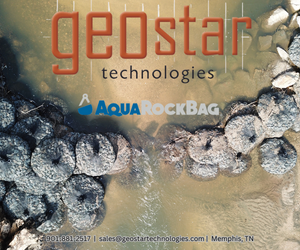
11 minute read
Building Momentum: Bipartisan Infrastructure Law
BY CRAIG COLLINS, AMERICA'S ENGINEERS
The Bipartisan Infrastructure Law helps accelerate some of the Corps of Engineers’ most urgent solutions – and create new ones – for communities throughout the states and territories.
Over the past two years, the U.S. Army Corps of Engineers (USACE) has had nearly 50 agreements and more than 100 construction activities underway thanks to more than $17 billion in funding from the Bipartisan Infrastructure Law (BIL). These projects are making a di fference for communities across the nation, from protecting against floods, to boosting commerce, to preserving and enhancing aquatic habitats.
The BIL has brought a transformative wave of investment in America’s water resources infrastructure. This unprecedented commitment entrusts USACE and its partners with the responsibility of shaping a resilient future for American water infrastructure.

“The Bipartisan Infrastructure Law is a historic investment in our nation’s water resources, and the U.S. Army Corps of Engineers is proud to be at the forefront of putting this funding to work,” said Edward E. Belk, USACE director of Civil Works. “Our portfolio of Bipartisan Infrastructure Law projects is adapting to tomorrow’s challenges while providing safety and security today to our citizens and the nation’s economy.”
The BIL is a once-in-a-generation investment in the nation’s infrastructure – which is the vital foundation for a strong and resilient economy. This investment empowers USACE to accelerate critical projects, ensuring the safety and security of our communities, businesses, and ecosystems.

The impact of the BIL extends far beyond the tangible improvements to our infrastructure. It represents a profound investment in the future of our nation; a future where our water resources are not only protected but also harnessed as catalysts for economic growth, environmental sustainability, and social equity.
• Improving the nation’s infrastructure. USACE teams are spearheading solutions that safeguard lives, property, and the environment. One example is the Fargo-Moorhead Flood Risk Management project, which will provide protection for nearly 260,000 people and 70 square miles of infrastructure from the impacts of flooding along the Red River and its tributaries. The BIL has provided a $437 million investment into this project, ensuring the full funding of the federal portion of this public-private partnership endeavor.
Across the nation, USACE is not just building dams and levees to protect against floods. It is also restoring vital ecosystems, as in the Caño Martín Peña project in Puerto Rico. This endeavor will breathe new life into the aquatic habitats that support a diverse array of marine life while protecting communities from environmental hazards. By reconnecting the San José Lagoon to the San Juan Bay, USACE will restore natural water flows, improve dissolved oxygen levels, and enhance the biodiversity of the San Juan Bay Estuary. This ecological revitalization will have a profound impact on the lives of the communities that call this area home, fostering economic growth and improving the overall well-being of all residents.
These examples illustrate the transformative power of the BIL and how USACE is not just repairing the past; it is building a brighter future for local communities.
• Facilitating safe, reliable, and sustainable commercial navigation to boost the resilience of the nation’s manufacturing supply chain. The BIL is playing a pivotal role in fortifying the nation’s manufacturing supply chain, ensuring the seamless flow of goods that underpin our economy. By enhancing the navigation systems that crisscross the country, USACE is not only bolstering efficiency but also safeguarding economic resilience.
The inland waterways system saves an estimated $7 billion to $12 billion annually compared to alternative modes of transportation. For instance, the 12 million tons of cargo that travel through Montgomery Locks and Dam would require a staggering 100,000 rail cars or 400,000 trucks to transport. By investing in these critical waterways, USACE is not just improving efficiency; it is safeguarding the very foundations of the nation’s economy.
In Alaska, USACE is embarking on a groundbreaking project to establish the first deep-water port in the U.S. Arctic region: the Port of Nome Modification Project. This transformation will not only boost economic activity in the region but also enhance its resilience to the impacts of climate change. By enabling larger vessels to reach Nome, the project will facilitate the delivery of essential goods and services to the 60 Alaska Native communities that depend on the port.

USACE’s commitment to supply chain resilience goes beyond construction and repair projects. In June 2023, the agency commenced dredging operations to deepen the navigation channel of the Arkansas River, a vital shipping route known as Marine Highway 40. This long-awaited project, stalled for decades due to inadequate funding, has finally moved forward thanks to the BIL. Once completed, the deepened channel will connect states as distant as Montana to the Gulf of Mexico, fostering economic growth and enhancing supply chain efficiency.
These examples underscore the BIL’s transformative power in bolstering America’s supply chain infrastructure. By investing in our inland waterways, coastal ports, and critical shipping routes, USACE is not only ensuring the smooth flow of goods, but also safeguarding the economic vitality and resilience of the nation.
• Advancing ecosystem and aquatic habitat restoration. USACE often partners with communities, states, or regional consortiums to perform ecosystem restoration that serves several purposes: increasing biodiversity and water resource availability, improving resilience to flooding, and enabling greater public enjoyment of nature. One of the largest investments of BIL funds – more than $1.1 billion –has been devoted to the most ambitious ecosystem restoration project ever undertaken: the ongoing suite of multi-benefit projects to revitalize the Florida Everglades. This unique and delicate ecosystem is home to hundreds of endangered plant and animal species, two Native American tribes, and provides drinking water to 9 million Floridians. The BIL provides funds to construct the Central Everglades Planning Project South S-356E Pump Station, the Indian River Lagoon South C-23/C-24 North Reservoir, and the Broward County Water Preserve Areas C-11 Impoundment. These projects will benefit widespread areas of this vast ecosystem, from estuaries in the north to inland wetlands to bays in the south.

While large-scale projects like the Florida Everglades capture the spotlight, smaller-scale restoration e fforts are no less vital to the communities they serve. In the Seattle suburbs, a partnership between USACE’s Seattle District and the city of Mountlake Terrace is transforming a former golf course at Ballinger Park into a thriving ecosystem. With BIL funding, the USACE team is restoring wetlands and riparian corridors, creating habitat for a diverse array of wildlife, and enhancing the creek’s health.
This project exemplifies USACE’s commitment to engineering with nature, a philosophy that integrates engineering solutions with natural processes to achieve sustainable water resources infrastructure. By incorporating native plants, restoring natural channels, and providing public access while minimizing environmental impact, the Ballinger Park project demonstrates the power of collaboration and innovation in ecosystem restoration.
Through these initiatives, the BIL is not just repairing the past; it is investing in a greener, more resilient future. By restoring our ecosystems and aquatic habitats, USACE is safeguarding natural capital, ensuring the health and well-being of communities for generations to come.
• Increasing resilience to climate change. Many of these efforts to improve navigation and supply-chain resilience, reduce flood and storm damage, and restore aquatic ecosystems include features aimed at increasing resilience to the effects of climate change. The effort to reduce the vulnerability of coastal communities has been boosted by the Biden administration’s Climate-Ready Coasts Initiative, which distributes $1.467 billion to support projects throughout the federal government.
On the West Coast, the BIL has so far allotted $30 million to support a recent partnership between the USACE Los Angeles District and the cities of Solana Beach and Encinitas, two of the most threatened segments of the California shoreline, where much of the beach has simply disappeared and waves are encroaching on seawalls. The effort to nourish these beaches will begin in Encinitas with the addition of a 50-foot-wide berm extending along 7,800 feet of shoreline, using 340,000 cubic yards of sediment. Eight miles south of Encinitas, along 7,200 feet of the Solana Beach shoreline, USACE will build a 150-foot-wide berm, using 700,000 cubic yards of sand. Each of these shoreline segments will be periodically renourished over a 50-year period of federal participation.
Turning to the Eastern Seaboard, the BIL has made $399 million available to accelerate the Resilient Norfolk Coastal Storm Risk Management Project, a transformative collaboration between USACE and the city of Norfolk, Virginia. This ambitious initiative aims to safeguard the Hampton Roads region, home to more than 1.8 million people, numerous historical sites, and a critical military presence. By employing a combination of structural and nature-based solutions, the project will erect floodwalls, levees, and tidal surge barriers, elevate vulnerable properties, and restore wetlands and oyster reefs. These multifaceted defenses will create a resilient coastline, shielding the region from the devastating impacts of coastal flooding and storm surges, and ensuring its long-term prosperity.



Throughout the nation, USACE is working tirelessly to enhance the resilience of the nation’s navigation infrastructure, supply chains, and aquatic ecosystems, integrating climate change considerations into every aspect of its work. This forward-thinking approach is not just about protecting infrastructure from the immediate impacts of climate change; it is about building a future where communities and ecosystems can thrive in a rapidly changing world.
• Investing in underserved communities to advance the Biden administration’s Justice40 initiative. The BIL is not just about restoring America’s infrastructure; it is also about bridging the gap between underserved communities and the opportunities they deserve. In line with the Biden administration’s Justice40 initiative, the BIL is ensuring that 40% of the overall benefits from certain projects reach communities that have historically been marginalized and overburdened by pollution, flood damage, and underinvestment.
Across the country, other underserved communities are reaping the benefits of the BIL. In California’s Watsonville and Pajaro valleys, 92% of the residents in Pajaro are Latino, and 14% live below the poverty line. These communities have endured a series of devastating floods in recent years, resulting in loss of life and over $700 million in damages. Thanks to BIL funds, the San Francisco District is now rebuilding the dilapidated levees that were constructed in 1963 to protect these vulnerable communities. Similarly, in Winslow, Arizona, where Latino and indigenous people make up the majority, and nearly a quarter of residents live in poverty, the Los Angeles District has allocated $65 million in BIL funds to overhaul the city’s aging levees. These investments are not just about infrastructure upgrades; they are about building a more equitable future for underserved of the residents in Pajaro are Latino, and 14% live below the poverty line. These communities have endured a series of devastating floods in recent years, resulting in loss of life and over $700 million in damages. Thanks to BIL funds, the San Francisco District is now rebuilding the dilapidated levees that were constructed in 1963 to protect these vulnerable communities. Similarly, in Winslow, Arizona, where Latino and indigenous people make up the majority, and nearly a quarter of residents live in poverty, the Los Angeles District has allocated $65 million in BIL funds to overhaul the city’s aging levees. These investments are not just about infrastructure upgrades; they are about building a more equitable future for underserved communities across the nation. By bridging the gap in infrastructure access and providing these communities with the resources they need to thrive, the BIL is fostering a more resilient and prosperous America for all.
The USACE portfolio of BIL projects is making a real di fference for communities across the nation. These projects are protecting people and property from floods, boosting the economy, preserving the environment, and promoting equity. USACE teams continue to look forward to working alongside their partners to deliver these projects for the nation.
To view a USACE video commemorating the second anniversary of the BIL, go to https://www.youtube. com/watch?v=da6ant7d_2Q










